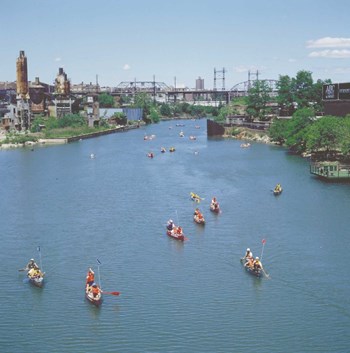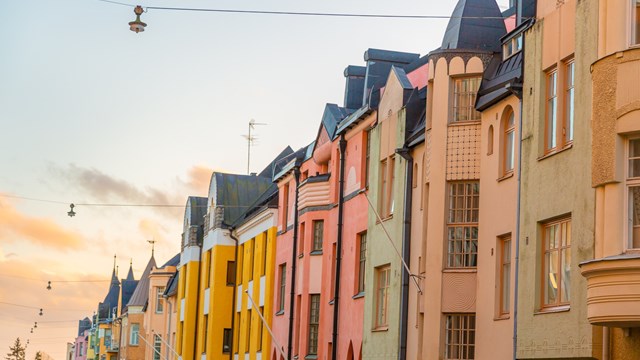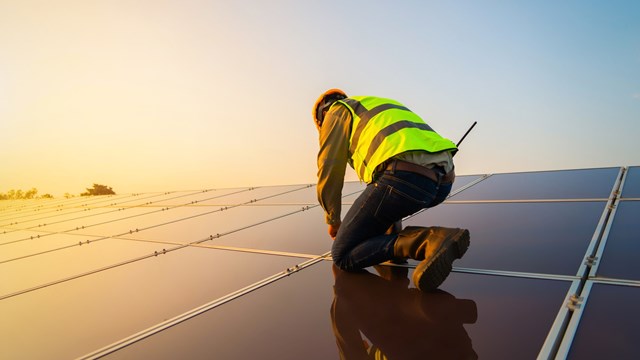
As a neighborhood, the South Bronx has struggled for nearly three decades under the negative connotations of its name as a flash point for violent crime, drugs, and unchecked urban decay. For many of those who live there, life is bounded on all sides by pollution and poverty.
Despite the South Bronx’s fearsome reputation—or perhaps because of it—lifelong South Bronx resident Majora Carter decided to take action and do what she could to help repair her neighborhood’s image and make it a safer, healthier place to call home. In 2001, Carter created Sustainable South Bronx (SSBx), an environmental justice solutions organization addressing land-use, energy, transportation, water & waste policy, and education to advance the environmental and economic rebirth of the South Bronx, and inspire solutions in areas like it across the nation and around the world.
Starting Out
“When she started this in 2001, she really started it with the mindset that the area needed to be an organization that did stuff from the ground floor,” says current SSBx Executive Director Miquela Craytor. “People would point to the South Bronx when discussing examples of urban flight as an example of what we don’t want to happen, and she grew frustrated with that. There wasn’t much energy being placed on what should happen and she set out to do that.”
The mandate from the beginning of the organization was to be proactive in the community and offering counter solutions to standard practice of development.
“They were alternative solutions provided for jobs, green space, healthy environments for the kids,” Craytor says. “It’s always been about looking for solutions to urban problems, solutions through economically, sustainable, viable projects.”
According to the latest census, more than 40 percent of South Bronx residents currently live at or below the poverty level. The neighborhood also houses 15 waste transfer stations and four power plants, so there are a number of issues that SSBx deal with each day.
Over the years the organization has grown considerably and has been a major factor in change being brought about in all sectors of the area through programs, policy and politics.
Finding Jobs
Although SSBx has many programs aimed at helping the area, the one that has been the most successful is their Bronx Environmental Stewardship Training, which is a Green Collar job training program.
“This is one of our main and largest programs,” Craytor says. “We have been doing this for five years and started off very small, but have been able to expand it to train more individuals and now we can train over 60 students a year.”
The program is a 10-week intensive program teaching environmental, health, poverty and quality of life problems by equipping urban residents to work in so-called “green collar” positions such as in ecological restoration, hazardous waste cleanup, green roof installation and landscaping.
“The people learning come from the South Bronx and East Harlem and other low income neighborhoods and learn skills that help them deal with ecological jobs. We are really creating pathways out of poverty,” Craytor says. “They are gaining skills that make them employable and also helps them retain that employment. One of the biggest struggles is ensuring they understand the nuances of being a good employee and showing up to work on time, not letting your personal life affect your job.”
Craytor is happy with the program’s success as it has placed 85 percent of the graduates in jobs, with another 10 percent furthering their education through college classes. In February a pilot program will look to expand the program with job training geared towards the indoor environment of working with green solutions.
“We are training people on how to help buildings be more energy efficient,” Craytor says. “Training how to weatherize buildings, how to look at windows, identify efficient lighting and assess the building and what goes into making a building efficient. From what we’ve seen in out research, there has been an increase in these types of jobs. We see this as a growth industry and training our candidates to be part of this growth. We’re very proud of our program and excited about the pathways they are on.”
Creating Policy
Helping to create policy is also a goal for SSBx and they try to aim their policy work as a complement to their programs.
“Last year we played an instrumental role with several coalitions in creating legislation to create incentives for green infrastructure, such as improving water quality and putting in more trees and green roofs,” Craytor says. “Both as a more cost effective way and as an economic benefit because it creates jobs. The green roof legislation that passed in June will create incentives for homeowners to offset costs for retrofitting their homes for increased energy efficiencies. We’re training folks who can get those opportunities.”
Their Green Roofs program provides space for urban agriculture, producing fresh, healthy food, and educational opportunities for kids and adults. They feel that this will also create employment opportunities as a higher demand for these roofs can be filled by many people from low-skill to professional levels.
“We encourage the use of native plant species on green roofs as opposed to selecting for appearance alone,” Craytor says. “We’ve also slowly been getting into creating program for green design and manufacturing. What we’re looking at is the landscape of the South Bronx and all the waste that comes through it and using it as a resource. Through a partnership with MIT we have the ability to have small scale equipment to remanufacture or up-cycle material. This is a great way for us to hit multiple pieces of engaging fun and creativity.”
The groups’ advocacy and outreach on policies affect the South Bronx community with an increased attention given to the environment. The South Bronx Greenway Project is a community led plan for a bicycle/pedestrian greenway along the South Bronx waterfront, which will provide much needed open space, waterfront access and opportunities for mixed used economic development.
“One of those events is a 5-K walk that is done on the route where the greenway will be,” Craytor says. “We have a number of outreach events and also fun events.”
The South Bronx Greenway will create bike & pedestrian paths around the Hunts Point and Port Morris waterfront, as well as on-street connections including Hunts Point Riverside Park, the Bazzini Piers, Tiffany St. Pier, and Barretto Point Park, and a connection to Randall’s Island Sports Complex.
Making a Difference
The Solid Waste and Energy program at SSBx aims to address the problems associated with the unjust clustering of polluting facilities that receive waste in all its forms, including rotting garbage, construction and demolition debris, fill material, waste water, and sewage sludge. It also works to address wasteful energy consumption and dirty energy generation that is located in the South Bronx. SSBx tackles these problems through a combination of advocacy activities aimed at winning increased community accountability for polluters, more protective government policies, and implementing environmentally sound and community friendly alternatives to current practices.
One example of an issue that SSBx feels strongly about is the new Yankee Stadium and their belief that they shouldn’t be getting any more tax incentive bonds with the money better being used to help the area.
“From our perspective, this is not the best time for them to ask for more corporate handouts and we are giving our testifying about this,” Craytor says. “When they city is looking to decrease funding for local groups, for a baseball team that is the most profitable in the nation, it doesn’t quite make sense.”
Another hot topic is the Sheridan Expressway, which they consider a poorly planned 1.25-mile redundant highway link in the South Bronx. Built at a time when Robert Moses dictated New York public works projects, the Sheridan Expressway is one of four expressways that has contributed to the blight, disinvestment and public health problems plaguing the South Bronx.
They are hoping to remove the short stretch of highway, which will reunite South Bronx neighborhoods, allow residents to access the newly restored Bronx River, and create space for parks, affordable housing and positive economic development.
The South Bronx handles a full 25 percent of New York City’s waste and has 15 waste transfer stations located within a one-mile radius. As part of the Organization of Waterfront Neighborhoods SSBx forcefully advocates to re-distribute New York City’s garbage equitably throughout all parts of the city, and to make garbage export less noxious, by eliminating long haul diesel trucks and replacing them with barge and rail export options. SSBx also works to get the best protections available for stations located in the South Bronx, and to establish benefit projects that serve to mitigate negative environmental impacts.
A Brighter Future
Craytor works with a full-time staff of 15, some part-time workers and a host of volunteers, who help on everything from cleaning up databases, creating a newsletter or just providing member support. There’s also a board that overseas the organization.
“Our board is involved in the programs and keeping us on track,” Craytor says. “What’s interesting is our mandate comes form the local level. Over seven years ago, the neighborhood needed jobs, wanted a cleaner environment and wanted a safer place for our kids to play. We want affordable housing and our mission is broad enough to help these in various ways.”
With a new president in office and economic uncertainty abound, SSBx is ready for the challenges that lie ahead.
“This is a great opportunity to do something different,” Craytor says. “I am looking forward to ’09 to lead this organization and connect with others to have a larger impact. We need to synergize our efforts, be strategic and work with one another. It’s a great time for change.”
Keith Loria is a freelance writer and a frequent contributor toThe Cooperator.






Comments
Leave a Comment